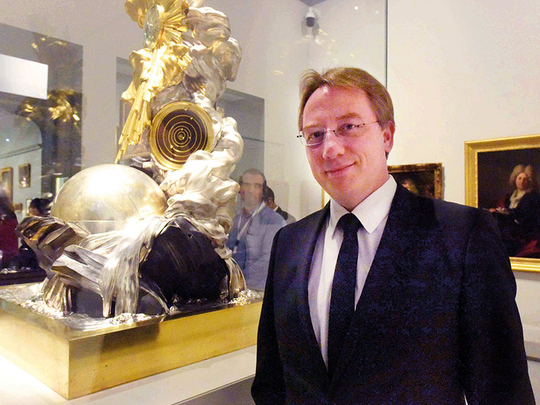
Abu Dhabi: Following its grand opening last month, the first temporary exhibition at the Louvre Abu Dhabi is set to open its doors this Thursday, and it will chronicle the birth of the world’s largest museum, the Musee Du Louvre in Paris.
The exhibition, which spans three wings and features about 150 objects and artefacts, shows how the renowned Louvre Museum in Paris came into being in the 18th century, and traces a little of its development in the early 19th century.
“The settings under which the two museums came into existence may be different, but this exhibition will shed light on the parallels they share, including a series of universal values and an exposition of the human condition,” Saif Saeed Gobash, director-general of the Department of Culture and Tourism – Abu Dhabi, said while addressing a press conference in the capital on Tuesday.
“Our goal is to intensify tolerance and cultural integration, and indeed, enhance the understanding of globalisation,” he added.
The Louvre Abu Dhabi was born of a 2007 intergovernmental agreement between the UAE and France. Under this, 13 French institutions will make four temporary exhibitions available over the next 15 years.
This exhibition, titled ‘From One Louvre to Another’, occupies building that is separate from the ones that house the Louvre Abu Dhabi’s permanent galleries. It has been curated by Musee du Louvre’s president-director, Jean-Luc Martinez, and its curator of prints and drawings, Juliette Trey. The pieces are mainly sourced from the Musee du Louvre, but a few are from the Palace of Versailles museum and other French institutions.
“The development of the Musee du Louvre into a museum for all was a transformational milestone for Paris, and through such displays of artwork and artefacts, and by sharing cultural knowledge, we hope the Louvre Abu Dhabi will be a similar milestone in the growth of the capital,” said Manuel Rabate, director of the Louvre Abu Dhabi.
Divided into three main wings, each prefaced by a film created specifically for the Louvre Abu Dhabi, the new exhibition starts with a glimpse into how the French royal art and artefact collection was once housed in the royal Palace of Versailles.
“Even as early as the 17th century, members of the public could walk into these gardens to experience the pieces on display, which included sculptures and installations of various types,” Trey said during a tour of the exhibit.
In a separate area, another temporary exhibition, Co-Lab, features the works of four UAE-based artists. These have been produced as part of the Emirati-French cultural programme, in collaboration with French manufacturers.
Introducing the installations, Ludovic Pouille, French ambassador to the UAE, said there will be even more opportunities for cultural collaboration in 2018, but refused to divulge further details.
“The Louvre Abu Dhabi and its associated programmes have opened a window for artists like me to explore our artistic depth, and also learn about the works of other cultures and civilisations,” said Zeinab Al Hashemi, 32, an Emirati artist who created a mess-and-glass-based installation as part of Co-Lab.
A quick walk: From One Louvre to Another
The exhibition is divided into three main wings, with a number of sections in each.
The first wing focuses on the French royal art collection that was initially on display at the Palace of Versailles.
Diana of Versailles |
A colourful painting shows French monarch Louis XIV in a painting, depicted as patron and protector of knowledge and the arts. A room leading off it features a range of sculptures and their recreations, as they were once displayed in the Versailles, before leading into a splendid red-walled room that mirrors the king’s grand apartment.
Here, one can take in the majestic sculpture of Diana of Versailles, a 2nd century copy of an ancient original that was gifted by the Pope to the French monarchy. This is also the first time the sculpture, one of the first ancient artefacts to become part of the French royal collection, has left France since 1556.
Bowl Vase: Byzantium, 10-11th century, enamelled gold, ruby, diamond. |
A handful of precious artefacts also show the king’s personal collection of artefacts and paintings, before opening on to the galleries that depict the development of the Louvre into a haven and workshop for all forms of artists in the 18th century, including painters, sculptors, woodworkers and clockmakers.
In the first of these second set of galleries is the ‘Creation of the World’ clock, a bronze sculpture that depicts the beginning of the world when the elements separated to form our planet. The piece, a testament to the genius of eighteenth century French clockmaking, has four different types of mechanisms, including a clock and a planisphere, and was designed as a gift for India. Instead, a series of events led it to be housed in the Musee du Louvre.
Barberini Vase, Syria, 1239-1260, made of copper alloy with engraved and inlaid design. |
Later galleries are arranged to mimic the French tradition of salons, wherein artists depicted their work in search of patrons and commissions. This covers the age when the Louvre Palace functioned as a workshop for artists, and their majestic paintings, brilliant sculptures and stunning artefacts are on display in these halls.
The final wing shows the birth of the Louvre as a museum in 1793, during the French Revolution, and its diversification into acquiring and exhibiting non-European art, including artefacts from Islamic and Pacific cultures.
As we walk out, a series of photographs of the Musee du Louvre’s galleries show the museum as it is now. Near them, a window offers a view into the brand new Louvre Abu Dhabi, which continues the conversation about the universality of culture.











